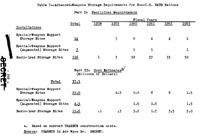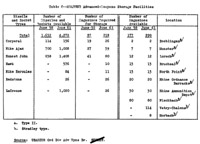If you do
NOT see the Table of Contents frame to the left of this page, then
Click here to open 'USArmyGermany'
frameset |
Special Weapons Depots
USAREUR
Looking for more information from military/civilian
personnel assigned to or associated with the U.S. Army
in Germany from 1945 to 1989. If you have any
stories or thoughts on the subject, please contact me . .
|
|
|
|
|
|
| Special Weapons Depots (59th Ord Bde) |
| |
| (Source:
Annual History, U.S. Army, Europe, 1 July 1957-30 June 1958) |
Planning for Advanced Weapons
Support
The Department of the Army programmed the issuance of seven types of
advanced weapons both to USAREUR and to NATO forces during the period from
the beginning of FT 1958 until the end of FY 1963. These weapons would
include Honest John and Little John rockets, Corporal/Sergeant, Redstone,
Lacrosse, and Hawk guided missiles, as well as Nike guided missiles of the
Ajax and the more powerful Hercules types.
NATO Support Functions
In May 1957 the Department of the Army had asked USAREUR to develop the logistical capability deemed essential to support all U.S. ground forces advanced weapons destined for Europe. The guidance provided for this purpose included information on supply support and maintenance responsibilities for missile systems and on atomic warhead supply and support.
Pertinent USAREUR plans were repeatedly revised during FY 1958. The first logistical support plan, dated 17 July 1957, was revised at the request of the Department of the Army, which asked for separate annexes dealing with supply, maintenance, transportation, communications, personnel and administration, and the proposed organization of required units. The revised plan, completed in February 1958, was again changed in May. This final plan was considered fundamentally sound, so that its vital data could be used by departmental staffs to initiate essential programming of advanced-weapons logistical support for non-U.S. NATO countries.
 a. Missile System Support. In accordance with the departmental directive of May 1957, USAREUR intended to establish Mutual Assistance Program (MAP) ownership accounts for the purpose of managing component repair parts and ancillary equipment for NATO missile systems. These parts and items of equipment were to be physically located in USAREUR depots, where they would be appropriately segregated. Inventory control points were to be established to perform separate supply and stock-control functions and maintenance-direction for the missile systems, to include calibration, surveillance, in-storage maintenance, and associated activities. USAREUR would accomplish all future resupply of repair parts, components, and ancillary equipment from the MAP ownership accounts. In addition, it would provide technical guidance and consultant services in order to aid the recipient NATO countries in establishing the required support systems and heavy-maintenance facilities. A 24-month supply of concurrent repair parts would be required for the initial basic load of direct- and heavy-support units and for minimum replenishment purposes. a. Missile System Support. In accordance with the departmental directive of May 1957, USAREUR intended to establish Mutual Assistance Program (MAP) ownership accounts for the purpose of managing component repair parts and ancillary equipment for NATO missile systems. These parts and items of equipment were to be physically located in USAREUR depots, where they would be appropriately segregated. Inventory control points were to be established to perform separate supply and stock-control functions and maintenance-direction for the missile systems, to include calibration, surveillance, in-storage maintenance, and associated activities. USAREUR would accomplish all future resupply of repair parts, components, and ancillary equipment from the MAP ownership accounts. In addition, it would provide technical guidance and consultant services in order to aid the recipient NATO countries in establishing the required support systems and heavy-maintenance facilities. A 24-month supply of concurrent repair parts would be required for the initial basic load of direct- and heavy-support units and for minimum replenishment purposes.
 b. Warhead Support. Under existing legislation U.S. personnel were to exercise maximum control over atomic weapons earmarked for non-U.S. NATO forces. For this reason, CINCUSAREUR was to have operational control of all units involved in monitoring, storage, maintenance, modification, operational readiness, custody, and security of atomic weapons to be furnished to other NATO countries. Before dispersing warheads in support of any non-U.S. unit, CINCUSAREUR was to insure that the respective country had observed the bilateral agreements concerning the security forces, installations, and procedures for the physical security of atomic warheads. To achieve the desired atomic readiness of the NATO delivery unit, most of its allocated weapons were to be the basic load stored in the immediate vicinity. The remaining weapons, constituting the reserve, were to be stored as a maintenance float by U.S. ordnance support units appropriately deployed to provide backup support. The basic load of surface-to-air missile warheads was to be assembled and retained on the racks at the launching site under the custody of U.S. personnel. b. Warhead Support. Under existing legislation U.S. personnel were to exercise maximum control over atomic weapons earmarked for non-U.S. NATO forces. For this reason, CINCUSAREUR was to have operational control of all units involved in monitoring, storage, maintenance, modification, operational readiness, custody, and security of atomic weapons to be furnished to other NATO countries. Before dispersing warheads in support of any non-U.S. unit, CINCUSAREUR was to insure that the respective country had observed the bilateral agreements concerning the security forces, installations, and procedures for the physical security of atomic warheads. To achieve the desired atomic readiness of the NATO delivery unit, most of its allocated weapons were to be the basic load stored in the immediate vicinity. The remaining weapons, constituting the reserve, were to be stored as a maintenance float by U.S. ordnance support units appropriately deployed to provide backup support. The basic load of surface-to-air missile warheads was to be assembled and retained on the racks at the launching site under the custody of U.S. personnel.
 (1) Unit Requirements. Because of this responsibility, one U.S. support detachment was to be allocated to each NATO surface-to-air missile battalion, whereas in the case of surface-to-surface missile units the ratio of support units would correspond to U.S. Army usage. Several U.S. Army support-group headquarters were to be established at command level, each of which was to administer a number of the detachments. These group headquarters were to be allocated according to the geographical area as well as to the density and dispersal of the custodial units. Finally, U.S. Army special-weapons support battalions located in various areas were to provide the maintenance for certain types of guided missiles. In all, the plan called for the establishment of 11 support-group headquarters, 116 surface-to-surface missile support detachments, 57 surface-to-air missile support detachments, and 15 special-weapons support battalions. The activation of these units was to be phased through FY 1963, as required. (1) Unit Requirements. Because of this responsibility, one U.S. support detachment was to be allocated to each NATO surface-to-air missile battalion, whereas in the case of surface-to-surface missile units the ratio of support units would correspond to U.S. Army usage. Several U.S. Army support-group headquarters were to be established at command level, each of which was to administer a number of the detachments. These group headquarters were to be allocated according to the geographical area as well as to the density and dispersal of the custodial units. Finally, U.S. Army special-weapons support battalions located in various areas were to provide the maintenance for certain types of guided missiles. In all, the plan called for the establishment of 11 support-group headquarters, 116 surface-to-surface missile support detachments, 57 surface-to-air missile support detachments, and 15 special-weapons support battalions. The activation of these units was to be phased through FY 1963, as required.
 (2) Storage Facilities. Requirements for storing atomic weapons included sites for basic loads and for the maintenance float (reserve). Initially all warheads were to be stored in basic-load sites, and only a relatively small number of maintenance-float facilities was planned at the special-weapons support storage sites, where additional igloos could be constructed if necessary. No basic-load storage facilities were to be constructed for surface-to-air missile units, since all such warheads mere to be stored in the ready sheds at the launching sites. (For further details, see Table 7.) (2) Storage Facilities. Requirements for storing atomic weapons included sites for basic loads and for the maintenance float (reserve). Initially all warheads were to be stored in basic-load sites, and only a relatively small number of maintenance-float facilities was planned at the special-weapons support storage sites, where additional igloos could be constructed if necessary. No basic-load storage facilities were to be constructed for surface-to-air missile units, since all such warheads mere to be stored in the ready sheds at the launching sites. (For further details, see Table 7.)
 c. Implementation. Although the plan had not yet been formally approved by 30 June 1958, it was already being implemented in support of an Honest John battalion that the Turkish Army activated during the month of June. c. Implementation. Although the plan had not yet been formally approved by 30 June 1958, it was already being implemented in support of an Honest John battalion that the Turkish Army activated during the month of June.
National Support Functions
 a. Receipt and Movement of Special Weapons. In August 1957 USAREUR published its new plan for the receipt and movement of the special weapons for which it was assigned responsibility by higher headquarters. The new plan was implemented on 12 December 1957, replacing the USAREUR Special Weapons Logistical Plan that had been in effect since early 1955. a. Receipt and Movement of Special Weapons. In August 1957 USAREUR published its new plan for the receipt and movement of the special weapons for which it was assigned responsibility by higher headquarters. The new plan was implemented on 12 December 1957, replacing the USAREUR Special Weapons Logistical Plan that had been in effect since early 1955.
 b. Helicopter Resupply. When USACOMZEUR asked for the assignment of one helicopter company, to carry out its advanced weapons support responsibility to the U.S. Seventh Army, French First Army, and NORTAF, adminstrative and technical difficulties prevented the previously directed "in-place" transfer of the 26th Transportation Company (Helicopter). In an effort to give USACOMZEUR the required helicopter lift, the Seventh Army was directed to make available the necessary elements of the company so that they could train for their priority mission. In the event of an emergency, the entire company, with the appropriate field maintenance detachment, was to be relieved from its assignment to Seventh Army and transferred to USACOMZEUR. A suitable installation was to be prepared for eventually stationing the company as close an possible to the advanced-weapons depots in France. The outright transfer of the company to USACOMZEUR was contingent upon the arrival of an additional helicopter company in Europe and the provision of appropriate facilities in France. b. Helicopter Resupply. When USACOMZEUR asked for the assignment of one helicopter company, to carry out its advanced weapons support responsibility to the U.S. Seventh Army, French First Army, and NORTAF, adminstrative and technical difficulties prevented the previously directed "in-place" transfer of the 26th Transportation Company (Helicopter). In an effort to give USACOMZEUR the required helicopter lift, the Seventh Army was directed to make available the necessary elements of the company so that they could train for their priority mission. In the event of an emergency, the entire company, with the appropriate field maintenance detachment, was to be relieved from its assignment to Seventh Army and transferred to USACOMZEUR. A suitable installation was to be prepared for eventually stationing the company as close an possible to the advanced-weapons depots in France. The outright transfer of the company to USACOMZEUR was contingent upon the arrival of an additional helicopter company in Europe and the provision of appropriate facilities in France.
 c. Storage. During FY 1958 storage facilities were needed to support 6 Corporal battalions, 4 Honest John battalions, 4 Honest John batteries, 6 Nike-Ajax battalions, and 1 Redstone missile group. In addition, the Department of the Army planned to deploy by the end of FY 1961 1 Honest John battalion, 1 Honest John battery, 4 Redstone missile groups, 4 Hawk missile battalions, and 6 Lacrosse missile battalions. The 6 Nike-Ajax battalions were to be converted to Nike-Hercules missiles by that time. During FY 1958 the existing Type II magazines were to be used for the storage of advanced weapons requirements. Future construction was to consist of two new structures designed by the Department of the Army: the Stradley magazine and the inert warehouse. The inert werehouse was to be used for the Corporal aftersection, with fins, and for the Redstone missile, while other weapons were to be stored in the Stradley or Type II magazines (Table 8). c. Storage. During FY 1958 storage facilities were needed to support 6 Corporal battalions, 4 Honest John battalions, 4 Honest John batteries, 6 Nike-Ajax battalions, and 1 Redstone missile group. In addition, the Department of the Army planned to deploy by the end of FY 1961 1 Honest John battalion, 1 Honest John battery, 4 Redstone missile groups, 4 Hawk missile battalions, and 6 Lacrosse missile battalions. The 6 Nike-Ajax battalions were to be converted to Nike-Hercules missiles by that time. During FY 1958 the existing Type II magazines were to be used for the storage of advanced weapons requirements. Future construction was to consist of two new structures designed by the Department of the Army: the Stradley magazine and the inert warehouse. The inert werehouse was to be used for the Corporal aftersection, with fins, and for the Redstone missile, while other weapons were to be stored in the Stradley or Type II magazines (Table 8).
 d. Prestock Points and Depots. The FY 1958 antiaircraft construction program included an advanced-weapons prestock point at Morbach, in WACOM. This project provided for the construction of 8 Stradley-type
magazines, 2 of which were to be modified for the storage of liquid propellants. The eight magazines were scheduled for completion dating FY
1960. The original FY 1958 construction program for France included 3
major ordnance class V facilities -- 1 at Captieux, in BASEC, and 2 in
ADSEC. USACOMZEUR had issued technical instructions for the Captieux
depot in May 1957, but four months later USAREUR suspended all further action on this project. The installation scheduled for Captieux was to be relocated in a more forward area and the 2 depots originally scheduled for ADSEC were to be combined into 1 facility. USACOMZEUR selected a site in the Verdun area for the facility previously scheduled
for Captieux and one at Vatry-Chalons for the second depot. The two
depot projects, which were to contain identical operational facilities,
were included in both the FY 1959 and FY 1959 construction programs for
France. The depot at Vatry-Chalons was scheduled for beneficial occupancy by the end of FY 1961; that at Verdun, by the end of FY 1962. The
Vatry-Chalons depot was to include 114 Stradley magazines, 5 Stradley
liquid-storage magazines, 1 guided-missile heavy-support shop, and 1
guided-missile and heavy-rocket explosive shop. In addition, each depot
included toxic-ammunition storehouses as well as administration and
assembly buildings. d. Prestock Points and Depots. The FY 1958 antiaircraft construction program included an advanced-weapons prestock point at Morbach, in WACOM. This project provided for the construction of 8 Stradley-type
magazines, 2 of which were to be modified for the storage of liquid propellants. The eight magazines were scheduled for completion dating FY
1960. The original FY 1958 construction program for France included 3
major ordnance class V facilities -- 1 at Captieux, in BASEC, and 2 in
ADSEC. USACOMZEUR had issued technical instructions for the Captieux
depot in May 1957, but four months later USAREUR suspended all further action on this project. The installation scheduled for Captieux was to be relocated in a more forward area and the 2 depots originally scheduled for ADSEC were to be combined into 1 facility. USACOMZEUR selected a site in the Verdun area for the facility previously scheduled
for Captieux and one at Vatry-Chalons for the second depot. The two
depot projects, which were to contain identical operational facilities,
were included in both the FY 1959 and FY 1959 construction programs for
France. The depot at Vatry-Chalons was scheduled for beneficial occupancy by the end of FY 1961; that at Verdun, by the end of FY 1962. The
Vatry-Chalons depot was to include 114 Stradley magazines, 5 Stradley
liquid-storage magazines, 1 guided-missile heavy-support shop, and 1
guided-missile and heavy-rocket explosive shop. In addition, each depot
included toxic-ammunition storehouses as well as administration and
assembly buildings.
 e. Support of the Northern Task Farce. The Northern Task Force
(NORTAF), formerly the 1st U.S. Artillery Task Force (Provisional), had
a wartime mission of providing atomic support to the Northern Army Group
(NORTHAG). Its peacetime mission was to be so trained, organized,
and equipped as to insure successful accomplishment of its wartime mission. NORTAF, or the 42d Field Artillery Group, was regularly assigned
to the U.S. Seventh Army for peacetime training, administration, and
logistical support. In the event of an emergency NORTAF would be
assigned to USAREUR (Theater Army) on order of CINCUSAREUR, who alone
had the authority to move the force -- or parts thereof -- when directed by
higher headquarters. If and when NORTAF was deployed to, or carried out peacetime training exercises in, the NORTHAG area, USACOMZEUR was to provide wartime advance-weapons support and post D-day resupply of atomic waepons as well as conventional logistical support. e. Support of the Northern Task Farce. The Northern Task Force
(NORTAF), formerly the 1st U.S. Artillery Task Force (Provisional), had
a wartime mission of providing atomic support to the Northern Army Group
(NORTHAG). Its peacetime mission was to be so trained, organized,
and equipped as to insure successful accomplishment of its wartime mission. NORTAF, or the 42d Field Artillery Group, was regularly assigned
to the U.S. Seventh Army for peacetime training, administration, and
logistical support. In the event of an emergency NORTAF would be
assigned to USAREUR (Theater Army) on order of CINCUSAREUR, who alone
had the authority to move the force -- or parts thereof -- when directed by
higher headquarters. If and when NORTAF was deployed to, or carried out peacetime training exercises in, the NORTHAG area, USACOMZEUR was to provide wartime advance-weapons support and post D-day resupply of atomic waepons as well as conventional logistical support.
|
|
| |
[1] The Type II magazine is an earth-covered structure with inside dimensions of 40 by 60 feet; it has vertical walls and a flat roof, giving an inside height of 15 feet. The magazine is capable of sustaining an overpressure of 14 pounds per square inch.
[2] The Stradley magazine is an earth-covered structure with inside dimensions of 26 by 80 feet; it has vertical walls, and the roof is barrel-arched, rising from a height of 8 feet at the walls to a crown of 14 feet. The magazine is designed to withstand an overpressure of 25 pounds per square inch without rupture. The inert warehouse, with inside dimensions of 100 by 200 feet, has the same physical characteristics and overpressure specifications as the Stradley magazine. |
|
|
| LIST OF SW DEPOTS |
| |
The storage sites indicated below are currently either still property of various NATO military agencies or are now owned by private citizens.
In any case, proper authorization to access these properties must first be obtained from the current owner if you plan to visit a site!!! |
| (Sources: Various, as indicated for each location) |
| ARMY GROUP LEVEL |
SUPPORTED UNIT |
DEPOT LOC. |
US ARMY CUSTODIAL DET |
| NORTHAG |
. |
. |
| . |
|
. |
| 2 ATAF |
. |
. |
| PERSHING |
Geilenkirchen ()  |
85th USAFAD, 557th USAAG |
| CENTAG |
. |
. |
| . |
|
. |
| 4 ATAF |
. |
. |
| PERSHING |
Lechfeld AB ()  |
74th USAFAD, 512th USAAG |
|
| CORPS LEVEL |
SUPPORTED UNIT |
DEPOT LOC. |
US ARMY CUSTODIAL DET |
| LANDJUT |
. |
. |
| LANDJUT |
Meyn (Flensburg)  |
99th Ord Det, 294th USAAG |
 ArtKdo 6, LANDJUT ArtKdo 6, LANDJUT |
Meyn (Flensburg)  |
75th USAFAD, 294th USAAG |
| NORTHAG |
. |
. |
| I NL Corps |
Lahn (Sögel) ? |
162nd Ord Co, 552nd USAAG |
 101st FA Gp 101st FA Gp |
Darp (Havelte. Neth.)  |
8th USAFAD, 552nd USAAG |
| I GE Corps |
Luedenscheid (Dortmund) 
Werlte (Sögel)  |
162nd Ord Co , 552nd USAAG |
 ArtKdo 1 ArtKdo 1 |
Werlte (Sögel)  |
1st USAFAD, 552nd USAAG |
 RakArtBlt 150 RakArtBlt 150 |
Diersfordt (Wesel)  |
1st USAFAD, 552nd USAAG |
| I UK Corps |
Telgte (Münster-Handorf)  |
583rd Ord Co, 570th USAAG |
| I BE Corps |
Telgte (Münster-Handorf)  |
583rd Ord Co, 570th USAAG |
 ArtKdo ArtKdo |
Telgte (Münster-Handorf)  |
4th USAFAD, 570th USAAG |
| CENTAG |
. |
. |
| III GE Corps |
Bellersdorf (Herbornseelbach)  |
96th Ord Co, 557th USAAG |
 ArtKdo 3 ArtKdo 3 |
Horressen (Montabaur)  |
83rd USAFAD , 557th USAAG |
 RakArtBtl 350 RakArtBtl 350 |
Horressen (Montabaur)  |
83rd USAFAD , 557th USAAG |
| V US Corps |
Münster, NATO Site 111 (Dieburg)  |
545th Ord Co, 72nd Ord Bn |
 41st FA Bde 41st FA Bde |
NATO Site ??, Fliegerhorst (Hanau) |
72nd Ord Bn? |
 42nd FA Bde 42nd FA Bde |
NATO Site 4 , Giessen Depot (Giessen) |
72nd Ord Bn ? |
| VII US Corps |
Siegelsbach, NATO Site 109 (Heilbronn)  |
525th Ord Co, 72nd Ord Bn |
 17th FA Bde 17th FA Bde |
NATO Site ?? () |
72nd Ord Bn? |
 72nd FA Bde 72nd FA Bde |
NATO Site ??, Kitzingen AAF (Kitzingen) |
72nd Ord Bn? |
 210th FA Bde 210th FA Bde |
NATO Site ?? () |
72nd Ord Bn? |
| II GE Corps |
Urlau 
Riedheim (Günzburg)  |
512th USAAG (moved to Riedheim 1965)
510th Ord Co, 512th USAAG |
 ArtKdo 2 ArtKdo 2 |
Großengstingen  |
84th USAFAD, 512th USAAG |
 RakArtBtl 250 RakArtBtl 250 |
Großengstingen  |
84th USAFAD, 512th USAAG |
| NIKE -HERC UNITS |
. |
. |
| NIKE-HERC |
Haarener Wald (Büren)  |
27th Ord Co, 5th USAAG |
|
| DIVISION LEVEL |
SUPPORTED UNIT |
DEPOT LOC. |
US ARMY CUSTODIAL DET |
| LANDJUT |
. |
. |
| ArtRgt 6, 6th PzGrenDiv |
Kellinghusen  |
13th USAFAD, 294th USAAG |
| I (NL) CORPS |
. |
. |
| 102nd FA Gp |
Doornspijk (t Harde, Neth.)  |
23rd USAFAD, 552nd USAAG |
| I (GE) CORPS |
. |
. |
| ArtRgt 1, 1st PzDiv |
Steyerberg (Liebenau)  |
32nd USAFAD, 552nd USAAG |
| ArtRgt 3, 2rd PzDiv |
Walsrode (?) 
Diensthop (Dörverden) 
|
25th USAFAD, 552nd USAAG (later moved to Diensthop) |
| ArtRgt 7, 7th PzDiv |
Visbeck (Dülmen)  |
81st USAFAD, 552nd USAAG |
| ArtRgt 11, 11th PzGrenDiv |
Dünsen (Delmenhorst)  |
5th USAFAD, 570th USAAG |
| I (UK) CORPS |
. |
. |
| 1st Armd Div |
() |
570th USAAG |
| 3rd Armd Div |
() |
570th USAAG |
| 4th Armd Div |
() |
570th USAAG |
| I (BE) CORPS |
. |
. |
| 13th Arty Gp |
() |
USAAG |
| III (GE) CORPS |
. |
. |
| ArtRgt 2, 2nd PzGrenDiv |
Rörshain  |
7th USAFAD, 557th USAAG |
| ArtRgt 5, 5th PzDiv |
Alten-Buseck (Giessen)  |
30th USAFAD, 557th USAAG |
| ArtRgt 12, 12th PzDiv |
Molzau (Philippsburg)  |
3rd USAFAD, 557th USAAG |
| V (US) CORPS |
. |
. |
| 3rd Armd DivArty |
() |
Ord Bn |
| 8th Inf Div Arty |
() |
Ord Bn |
| VII (US) CORPS |
. |
. |
| 1st Armd Div Arty |
() |
Ord Bn |
| 3rd Armd Div Arty |
() |
Ord Bn |
| II (GE) CORPS |
. |
. |
| ArtRgt 4, 4th PzGrenDiv |
Hemau (Hemau)  |
36th USAFAD, 512th USAAG |
| ArtRgt 10, 10th PzDiv |
Mottschiess (Pfullendorf)  |
2nd USAFAD, 512th USAAG |
| ArtRgt 8, 1st GebDiv |
Leeder (Landsberg)  |
24th USAFAD, 512th USAAG |
|
| |
|
[1] CORRECTION: Klaus Stark, Germany, sent an email recently with the following comments: The SW ammo depot between Alten-Buseck and Daubringen in the vicinity of Gießen (http://www.lostplaces.de/giessendepot/index.html -- Nov 2010: site has changed names, now Geschichtsspuren.de) is NOT Nato Site #4. It is the special weapons depot that stored nuclear warheads (under the custody of the 30th USAFAD) for the German Artillerieregiment 5 (part of the Bundeswehr's 5th Panzer Division).
Nato Site #4, on the other hand, is actually located on Giessen Army Depot. It can be identified as a rectangular area (double perimeter fencing) just south of the airfield (top of the Giessen Army Depot installation map). Additional photos can be seen at http://www.ezshots.com/album.cgi?coldwar1/NATO-SITE-4-Summer-1999.
[2] Source: Reservistenkameradschaft Dieburger Land web site. Webmaster is René Oestreicher; photos are courtesy of Marco Klinkerfuß of Dieburg.
[3] Source: Atomwaffenlager in Niedersachsen - a very detailed and well researched page on the Relikte.com web site |
|
| |
| (Source: D-SAT 5 ) |
SW Depots (closed)
Satellite views |
|
|
|
|
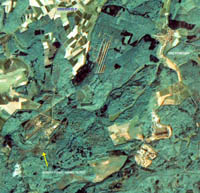
1. Kriegsfeld, late 1990s (289 KB)
|
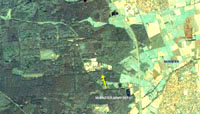
2. Muenster-Dieburg, late 1990s (172 KB)
|
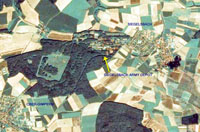
3. Siegelsbach, late 1990s (171 KB)
|
|
|
|
| |
| (Source: Ron Buckholz, Kriegsfeld Special Weapons Depot web site) |
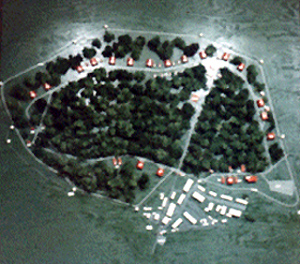
|
|
Kriegsfeld SW Depot
Image at left is a very nice model of the special ammo depot that was made on a large piece of plywood and that was on display in the orderly room.
This is actually the entire Northpoint site. The two igloos on the far right close together are the assembly bunkers. The top was where we disassembled, tested, and then reassembled the weapons. The bottom of the two was the maintenance building where we painted and repaired the weapons containers.
All the white buildings at the bottom were the operations area. The offices and barracks, motor pool, clubs, fire station, etc. were all down there. Hope that helps you out! |
|
|
|
|
|
|
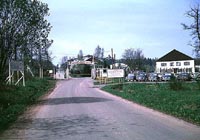
1. Main gate, late 1970s (KB)
|
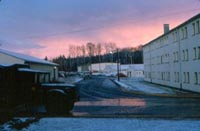
2. Sunset (KB)
|
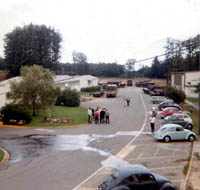
3. Some men wait for a bus into K-town (KB)
|
|
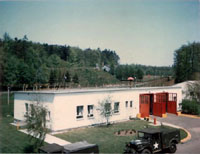
4. Fire station (KB) |
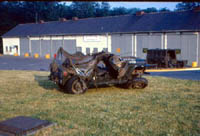
5. Motor pool (KB) |
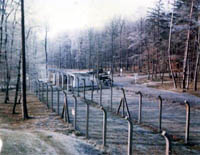
6. Gate (KB) |
|
|
|
|
If you have more
information on the history or organization of the Special weapons depots, please contact me . . |
|
|
|
|
Related Links:
Giessen SW Depot - great page on the special weapons depot at Alten Buseck (near Giessen). Authored by Alex Leib, Lich, Germany.
Kriegsfeld Special Weapons Depot - North Point - Ron Buckholz has a web site that focuses on the special weapons depot at Kriegsfeld and the units that operated the depot. Great photos and several newsletters. |
| |
| |
| |
|

